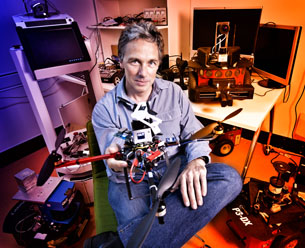Engineerblogger
Nov 3, 2011
A flying robot as small as a dinner plate that can zoom to hard-to-reach places and a fleet of eco-friendly robotic farm-hands are just two of the exciting projects the robotics team at the Queensland University of Technology (QUT) is working on.
The pint-sized propellor-powered robots can be packed away into a suitcase. They have multiple cameras which enable them to 'see' the world around them as they navigate their way through buildings, carrying out tasks like deliveries or inspections.
"You'll be able to put your suitcase on the ground, open it up and send the flying robot off to do its job," said Professor Peter Corke, from the Faculty of Built Environment and Engineering.
"These robots could fly around and deliver objects to people inside buildings and inspect things that are too high or difficult for a human to reach easily.
"Instead of having to lower someone down on a rope to a window on the seventh floor, or raise them up on a cherrypicker, you could send up the flying robot instead."
The QUT researchers are using cost-effective technology so the robots are affordable. Within the next year, it may be possible to attach arms to the device so it can also fix things.
Professor Corke said his team were busy working out the technical challenges.
"We need to keep it safe when it's up near solid things like power poles, or the edge of a building. It also needs to be able to keep its position when the wind is blowing," he said.
Professor Corke and his team, including fellow researcher Dr Ben Upcroft, are also researching ways to create lightweight agricultural robots, equipped with cameras, that have advanced navigation capability, cooperate in teams to cover large areas and resupply themselves - all while causing less soil damage and applying herbicide more intelligently.
"Farmers are currently using machines which indiscriminately spray herbicide across the crop, which is expensive and not very environmentally friendly," Dr Upcroft said.
"The (robot's) camera can look at the area surrounding the robot and the image recognition software will pick out features of the weed which make it different to the rest of the crop."
The three-year project, which was recently awarded nearly $400,000 in funding from the Australian Research Council, is being conducted with the University of Sydney and Queensland farmer Andrew Bate, who runs Advanced Agricultural Systems.
Source: Queensland University of Technology (QUT)

0 comments:
Post a Comment